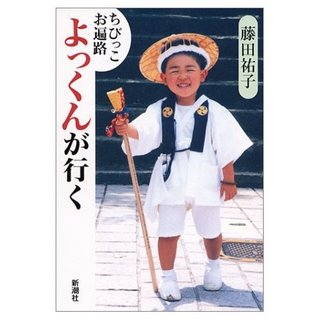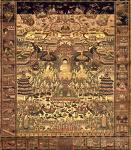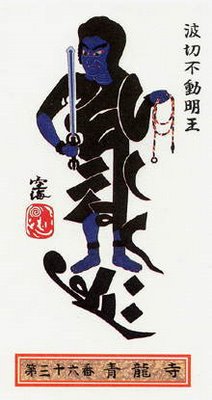:::::::::::::::::::::::::::::::::::::::::::::::::::::::::::::::::::::::::::::::::::::::::::::::::::::
General Henro Information
四国お遍路さん Pilgrims in Shikoku
to 88 temples in honor of Kobo Daishi Kukai

In the Beginning was a sacred mountain
Koya-San 高野山
Koya San in Wakayama
Kobo Daishi Kukai 弘法大師 空海
(Kooboo Daishi, Kuukai )
. Shikoku Henro Temple List .
from the Darumapedia
With many Henro trails of Japan
. Amulets for the Kukai Pilgrim .
. Pilgrim's Stamp Book 納経帳 nookyoochoo .
:::::::::::::::::::::::::::::::::::::::::::::::::::::::::::::::::::::::::::::::::::::::::::::::::::::
Haiku and Henro:
.... . The Henro Pilgrimage
Two short Haiku Henro Trips,
Gabi Greve, Summer 2005
元日にかわいや遍路門に立
ganjitsu ni kawai ya henro kado ni tatsu
on New Year's day
a cute little pilgrim
at the gate
Issa, Tr. by David Lanoue

ちびっこお遍路よっくんが行く
藤田祐子/著. 新潮社
Here is the diary of a Henro walk from a cute little pilgrim with his Grandmother, Yuko Fujita. Fujita san visited my Daruma Museum the other day !
かわいや遍路の日記
佳宏と祐子ばあちゃんの「お四国遍路」
ようこそ!
:::::::::::::::::::::::::::::::::::::::::::::::::::::::::::::::::::::::::::::::::::::::::::::::::::::
My Shiraishi Henro Walk, Okayama Prefecture
白石島の遍路道 岡山県
My Daruma Dolls from Shikoku ... 四国のだるまさん
Glossary of Henro Pilgrims Vocabulary

Two on a Pilgrimage:
The 88 Holy Places of Shikoku
by Alfred Bohner (Author), David Moreton (Editor)
In the summer of 1927, Alfred Bohner embarked on the 1,200 kilometer pilgrimage around the island of Shikoku. Four years later, he published this comprehensive and informative book
. . . amazon com
:::::::::::::::::::::::::::::::::::::::::::::::::::::::::::::::::::::::::::::::::::::::::::::::::::::
quote
A Journey with no end
Presently, the annual number of walking pilgrims is 1000
It is said that today 100,000-200,000 people travel around the Shikoku pilgrimage route annually with most people going by car or bus, however around 1,000 people walk. The standard motives for doing the pilgrimage are
1) to pray for safety in the home and
2) remembrance of ancestors.
However, in the case of walking pilgrims, who might do it for such reasons as mentioned above might also the pilgrimage for ascetic training, just to walk it or for a spiritual reason such as to "find oneself" or "to soothe one's soul" or for personal training.
The pilgrim attire, such as the white vest and Kongo staff, act as a way to clearly separate pilgrims from regular travelers and if one also includes the hat, gloves and leg bands one becomes an even more full-dressed pilgrim. Even in the present day, most pilgrims wear such attire and walk the mountains and roads of Shikoku and although this appearance may look strange in the big cities, it fits in with the landscape of Shikoku.
While there are many motives for journeying on the Shikoku pilgrimage route, in most cases, people return home with a greater degree of satisfaction than they had expected to have before they departed. And while the struggle and conquest over bad roads, bad weather and one’s stamina are important as experiences to help one focus on oneself, the one thing that impresses all people the most is the receiving of charitable gifts along the way which is the representative way of interaction between the pilgrims and the local people.
O-settai (Charitable Gifts)
Osettai is the action of giving presents, such as food, by the local people to pilgrims. In olden times, vending machines and convenience stores did not exist so due to this form of giving pilgrims were able to survive the journey. Rice and tissue were important items of osettai. On one hand, from the religious viewpoint of the local people, giving to pilgrims was important because they are considered to be the transformed body of Kobo Daishi and that pilgrims will go around to each temple on my behalf. As well, the gifts given will not only act as a form of assistance to someone struggling along the pilgrimage route, but that those goods are actually gifts to the Gods.
The custom of osettai is still prevalent today; however those who travel by car and bus while have few opportunities to experience this charity. On the other hand when one becomes a walking pilgrim there will be many occasions to receive osettai from people one passes on the road or from people who live in the homes one passes. By wearing the garb of a Shikoku pilgrim, one is recognized as an OHenro-san and one can exchange warm greetings with others who will be receptive and show you the way. This experience is quite removed from the present-day lifestyle in which one must obtain and maintain one’s place in society through self expression.
This homepage offers practical information for becoming a Shikoku pilgrim with a focus on walking pilgrims.
source : Hiroshi Kushima
Kikusui Henro House

Rice Crackers for the Pilgrim !
:::::::::::::::::::::::::::::::::::::::::::::::::::::::::::::::::::::::::::::::::::::::::::::::::::::
................ External Links
Mark Schumacher on the subject
Introduction
Terms / Concepts
Pilgrimage Stamps
Stamp Books
Pilgrimage Scrolls
Prayer Slips
Pilgrimage Seals
Sacred Images
eStores for Pilgrims
Top Pilgrimages List
Deity-Specific Circuits
Shikoku 88 Pilgrimage !!!
Hyakudo Mairi
Holy Mountains
Sacred Shrines
Holy Mountains & Sacred Shrines in Japanese Buddhism & Shintoism
::: ::: ::: ::: :::
Journal of a Pilgrim
with Haiku and Tanka
The real voyage of discovery
consists not in seeking new landscapes,
but in having new eyes.
. . . Join Dave Turkington
.......................................................................

A young woman of 24 set off alone in 1918 to walk the 1400 kilometre pilgrimage route around the island of Shikoku. Her dream of a solitary journey ended when an old man of 73 met early on her journey insisted that he accompany her as servant and protector because he believed that she was an attendant of Kannon Bosatsu.
This book is her account of their extraordinary experiences during the five month journey. The 105 newspaper articles that she wrote while making her pilgrimage made her a celebrity in Japan. In later years the woman, Takamure Itsue, became well known in Japan as a poet, intellectual, scholar, historian, feminist and anarchist.
- amazon com -
:::::::::::::::::::::::::::::::::::::::::::::::::::::::::::::::::::::::::::::::::::::::::::::::::::::
........................... Japanese LINKS
Introducing most online material for each temple !
四国八十八箇所 お遍路ポータル
四国霊場 Shikoku Reijo
- source : www.88shikokuhenro.jp
:::::::::::::::::::::::::::::::::::::::::::::::::::::::::::::::::::::::::::::::::::::::::::::::::::::::::::::::::::::::::::

Zen Art by Qiao Seng, Sad Monk
:::::::::::::::::::::::::::::::::::::::::::::::::::::::::::::::::::::::::::::::::::::::::::::::::::::::::::::::::::::::::::
observance kigo for late spring
o-fuda nagashi, ofudanagashi お札流
floating of temple amulets
From Temple Nr. 44 大宝寺 to 53 円明寺 in the Matsuyama region, the amulets of pilgrims are floated in the sea at Takahama beach 高浜沖.
On the 28th day of the third lunar month, now in April.
. OBSERVANCES – SPRING SAIJIKI .
Amulets for strong legs during the pilgrimage :

CLICK for more waraji 草鞋 straw sandal amulets.
. waraji 草鞋 zoori 草履 straw sandals and amulets .
. Amulets and Talismans from Japan .
ashi koshi 足腰お守り for strong feet and legs
. Henro 四国お遍路さん Henro Pilgrims Dolls from Shikoku .
. shichinin misaki 七人ミサキ "Misaki of seven people" .
Groups of seven Henro pilgrims killed or died in Shikoku.
:::::::::::::::::::::::::::::::::::::::::::::::::::::::::::::::::::::::::::::::::::::::::::::::::::::
The Shikoku Pilgrimage, henro 遍路,
comprises many kigo for spring and autumn.
. KIGO for the henro pilgrimage .
[ . BACK to WORLDKIGO . TOP . ]
[ . BACK to DARUMA MUSEUM TOP . ]
- #henro #shikokuhenro #kobodaishi -
:::::::::::::::::::::::::::::::::::::::::::::::::::::::::::::::::::::::::::::::::::::::::::::::::::::



















































